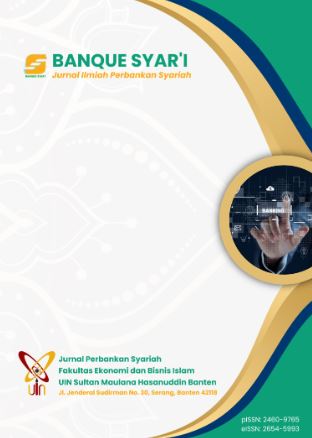Strategi Optimalisasi Daya Saing Bank Syariah Pasca Merger Bank-Bank Syariah BUMN
DOI:
https://doi.org/10.32678/bs.v9i2.9168Keywords:
Merger, Competitiveness, BUMN, Sharia Banks, BSIAbstract
Mergers are an important part of restructuring financial operations and increasing opportunities to increase the share of the Sharia banking market in Indonesia. This study aims to analyze the strategy for optimizing the competitiveness of Islamic banks after the merger of state-owned Islamic banks. This type of research uses field research. This research approach uses qualitative. The research setting is located at Bank BSI KC Pekalongan Pemuda. The subject of this research is Bank Syariah Indonesia (BSI) KC Pekalongan Pemuda, namely the Branch Operations and Service Manager and Marketing Financing at BSI KC Pekalongan Pemuda. The main sample of this research data source is informants consisting of employees and customers of Bank BSI. The data collection technique uses the trinulation technique which is a combination of observation, interview, and documentation techniques. Data analysis used a data credibility test with triangulation techniques from different data. Analysis of the data used in the study used interactive model data analysis by Miles and Huberman. The results of this research conclude that Bank Syariah Indonesia officially carried out a merger on February 1, 2021. The formation of the merger made Bank Syariah Indonesia superior in terms of large capital. Competitiveness optimization strategy by taking several steps. First, sharia awareness. BSI KC Pekalongan Pemuda is a media for preaching the concept of Islamic teachings in Sharia banking practices of Openness, Accountability, Professionalism, and Justice. Second, the strategy plan continues to develop to improve it in line with the problems faced by BSI to achieve a competitive advantage. BSI KC Pekalongan Pemuda’s special strategy focuses on commercial patterns in marketing all products by focusing on several agencies such as education centers, health services, offices, and industries to gain a wide network. Third, digitization makes it easy to provide services that only by using a cellphone can be reached easily.
Downloads
References
Ab-Hamid, M. (2018). Market risk and efficiencies of the Malaysian banking industry: The post-merger and acquisition examination. Jurnal Ekonomi Malaysia, 52(1), 1–12.
Abdullah, T. M. K. (2018). Employee experience in mergers & acquisition process towards M & A success: The case of Maybank Acquisition on Bank International Indonesia. Journal of Social Sciences Research, 2018, 100–104. https://doi.org/10.32861/jssr.spi6.100.104
Adam. (2022). Perubahan produk dan jasa BSI.
Ahmad Suhaimi, M.A. (2021). Studi Manajeman Risiko Pada Bank Syariah Indonesia (BSI). Jurnal Manajemen Risiko, 2(I). https://doi.org/10.33541/mr.v2ii.3438
Anggraini, Y. (2021). SKRIPSI Oleh : Awal Setiawan NIM : 210817072 Pembimbing :
Arthaloka, G. (2008). Perbankan Syariah pkes publishing.
Ascarya. (2013). Akad dan Produk Bank Syariah. Rajawali Pers.
Bhatta, M. K. (2017). Effect of Bank Merger on the Shareholders Wealth and Post-Merger Situation of Nepalese Banking Industry. Вестник Росздравнадзора, 6(4), 5–9.
BSI. (2021). Kebijakan Manajemen Risiko PT Bank Syariah Indonesia. 1–98.
Erni. (n.d.). Implikasi penerapan merger BSI.
Fachryana, F. A.-H. (2020). Manajemen Risiko Strategis Bank Syariah. Jurnal Manajemen, Ekonomi, Keuangan Dan Akuntansi, 1(2), 61–66.
Junaedi, D. I. (2017). Antisipasi Dampak Social Engineering Pada Bisnis Perbankan. Infoman’s, 11(1), 1–10. https://doi.org/10.33481/infomans.v11i1.13
Ketua, K., Pengawas, B., Modal, P., Usaha, P., Peleburan, A., Perusahaan, U., Pengawas, B., Modal, P., Gede, I. P., & Suta, A. R. Y. (1997). Kep Ketua Bapepam No Kep52Pm1997. 1–5.
Kowalik, B. M., Davig, T., Morris, C. S., & Regehr, K. (2007). Bank Consolidation and Merger Activity Following the Crisis. Economic Review, 31–50.
Mai, M. U., & Nurdin, A. A. (2020). Pola Kinerja Perusahaan Sesudah Merger dan Akuisisi serta Analisis Terhadap Faktor-Faktor yang Mempengaruhinya. Jurnal Riset Akuntansi Dan Keuangan, 8(2), 431–446. https://doi.org/10.17509/jrak.v8i2.20064
Mandiri, B. S. (2013). Sejarah Bank Syariah Mandiri. Http//Www. Syariahmandiri. Co. Id/Tentang-Kami/Sejarah, 5(1), 1–15.
Mardiaynto, E. (2021). Implementasi Marketing Mix Dalam Pemasaran Perbankan Syariah. Al Iqtishod: Jurnal Pemikiran Dan Penelitian Ekonomi Islam, 9(1), 93–103. https://doi.org/10.37812/aliqtishod.v9i1.227
Mohiuddin, M. (2014). Banking Business: Quick Response Strategy for Competitive Edge. 1(1), 95660042.
Nim, A. (2022). Persaingan Lembaga Keuangan: Strategi Merger Bank Syariah Indonesia (BSI).
OJK. (n.d.). Prinsip dan Konsep Dasar Perbankan Syariah. Otoritas Jasa Keuangan (OJK).
Oktaviani, S., & Basyariah, N. (2019). Analisis Manajemen Risiko Layanan Mobile Banking Pada Bank Syariah. 32–37.
Putra, F. and M. N. H. . (2016). 6976-21321-1-Sm (2). November, 952–967.
Raharjo, V. N. P. (2014). ANALISIS KINERJA KEUANGAN BANK SEBELUM DAN SESUDAH MERGER (Studi Kasus Pada Bank Niaga dan Bank Lippo yang Merger menjadi Bank CIMB Niaga).
Santoso, R. T. (2010). Pengaruh Merger dan Akuisisi Terhadap Efisiensi Perbankan di Indonesia (Tahun 1998-2009). Jurnal Akuntansi Dan Keuangan, 12(2), 102–128. https://doi.org/10.9744/jak.12.2.pp.102-128
Saraswat, E. (2019). Determining the impact of merger on performance of the banks in terms of return on assets (Roa): Case review of state bank of India and state bank of Indore merger. Journal of Advanced Research in Dynamical and Control Systems, 11(7), 248–252.
Siauwijaya, R. (2017). The Evaluation of Bank Efficiency in Post Merger Stage in Banking Industry. Binus Business Review, 8(2), 133. https://doi.org/10.21512/bbr.v8i2.1452
Sugiyono. (2013). Metode Penelitian Kuantitatif Kualitatif Dan R&D. Alfabeta.
Sugiyono. (2020). Metode Penelitian Kualitatif. ALFABETA.
Sundari, R. I. (2017). Kinerja Merger dan Akuisisi pada Perusahaan Go Public. Telaah Bisnis, 17(1), 51–64. https://doi.org/10.35917/tb.v17i1.43
Witjaksono, A. (2011). Manajemen Risiko Dalam Perbankan Syariah. Jurnal GICI, 1(1), 95–115.
Published
How to Cite
Issue
Section
License
Copyright (c) 2023 Hendri Hermawan Adinugraha

This work is licensed under a Creative Commons Attribution-NonCommercial-ShareAlike 4.0 International License.










